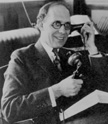CHARLES F. KETTERING (1876-1958)
The Man
Charles Franklin Kettering was born on a farm near Loudenville,
Ohio, August 29, 1876. After graduation from high school,
he accepted a teaching position in a one-room rural school.
Although highly successful as a teacher, his mind was set
on going to college.
In the summer of 1896, he entered the College of Wooster
(Ohio). As a result of long and intense hours of study,
his eyesight deteriorated to the point that he was forced
to leave college and return to teaching.
In 1898, he entered the engineering school at Ohio State,
but again his poor eyesight forced him to drop out during
his freshman year. For the next two years he worked on a
telephone line crew, and then once again entered Ohio State,
finally completing his electrical engineering degree in
1904.
After graduation, Kettering took a job in the inventions
department at the National Cash Register Company (NCR) in
Dayton, Ohio. There he developed an electric motor for cash
registers, the OK Charge Phone for department stores, and
several other contributions to a revolution then taking
place in business machines.
In 1909, Kettering and Edward A. Deeds, his associate at
NCR, formed their own industrial research laboratory, the
Dayton Engineering Laboratories Company (later known as
DELCO). Within three years, they had produced a new all-electric
starting, ignition, and lighting system for automobiles.
The system first appeared as standard equipment on the 1912
Cadillac and, as its use spread, women could conveniently
become drivers without the assistance of a chauffeur. DELCO
was eventually sold to General Motors and became the foundation
for the General Motors Research Corporation, of which Kettering
became vice president in 1920.
The list of innovations and inventions that are credited
to Charles F. (nicknamed "Boss") Kettering is
impressive. His book of patents contains more than 300 separate
applications that range from a portable lighting system
for farms to coolants for refrigerators and air conditioners.
Other patents included a World War I "aerial torpedo,"
a device for the treatment of venereal disease, and an incubator
for premature infants. Duco paint and Ethyl gasoline were
also his ideas, and he was instrumental in their development.
He was interested in the development of diesel engines and
solar energy, and was a pioneer in the application of magnetism
to medical diagnostic techniques.
He and his wife, Olive, had one son, Eugene Williams Kettering,
who working with his father on diesel engine development
and was largely responsible for the adaption of the diesel
engine to railroad use. "Boss Ket" retired from
General Motors Research in 1947 but served as a consultant
over the next decade. Following a series of strokes, he
died on November 24, 1958.
His Interest in Education
When approached to support an early concept of "practical
education" he observed "that people learned not
only with their minds, but with their eyes and ears and
hands." He was expressing his unfaltering confidence
in the superiority of an educational concept derived from
his own teaching experience as well as involvement with
several cooperative education institutions.
Kettering's relationship to the former General Motors Institute
-- now Kettering Institute -- can best be described as that
of a godfather. It began with his first talk in Flint in
1916, 10 years before General Motors decided to take over
the school. Walter Chrysler, chairman of the Industrial
Committee of the YMCA, invited Kettering to Flint to talk
about his views on practical education. On that occasion
Kettering noted:
"Modern psychology teaches that experience is not
merely the best teacher, but the only possible teacher.
There is no war between theory and practice. The most valuable
experience demands both, and the theory should supplement
the practice and not precede it. Briefly, the cooperative
job is the student's laboratory in which he learns the details
of his profession."
Inspired by Kettering's presentation, the Industrial Committee
of the YMCA arranged for factory workers to receive instruction
adapted for their work in the factories. Under the committee's
supervision, the resulting School of Automotive Trades offered
a variety of classes over the next three years. Out of these
early efforts to combine learning with practical needs came
the formation of the Flint Institute of Technology in 1919
and the entrance of General Motors Institute in 1926.
Speaking at the General Motors Institute's commencement
in August 1932, Kettering said, "I think that the greatest
education in the world is the education which helps one
to be able to do the right things at the time it has to
be done."
In 1941 on a similar occasion, he observed, "If we
taught music the way we try to teach engineering, in an
unbroken four-year course, we could end up with all theory
and no music. When we study music, we start to practice
from the beginning, and we practice for the entire time,
because there is no other way to become a musician. Neither
can we become engineers just by studying a textbook, because
practical experience is needed to correlate the so-called
theory with practice."
Thus Kettering reiterated his belief in the value of a
practical education, a blending of theoretical knowledge
with experience and common sense, to do the right thing
at the right time.
Boss Ket's interest in his godchild, GMI, continued throughout
his General Motors career, and throughout his life. The
Kettering Archives are appropriately located at Kettering
Institute. Students and researchers are constantly impressed
and amazed at the range of Kettering's interests, as well
as the wisdom and common sense of his practical approach
to engineering and life.
His numerous speeches and writings are replete with references
to GMI and on many occasions he was eagerly sought as commentator,
consultant, commencement speaker, and alumni program guest.
He never once failed to extol the advantages of hands-on
learning and the dedication of GMI to that principle of
education.




